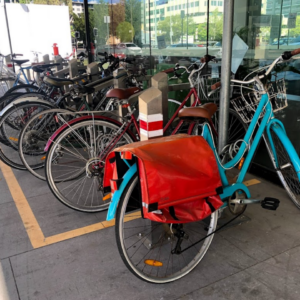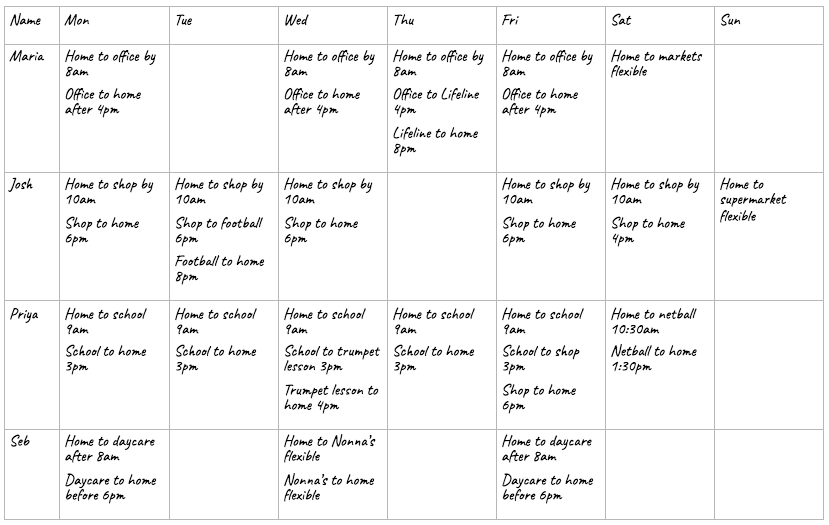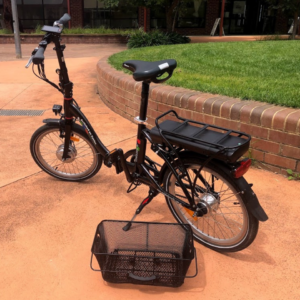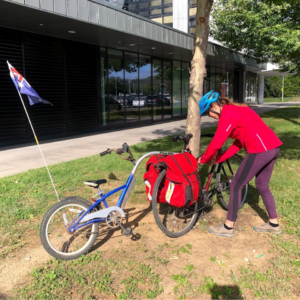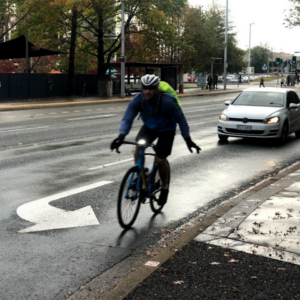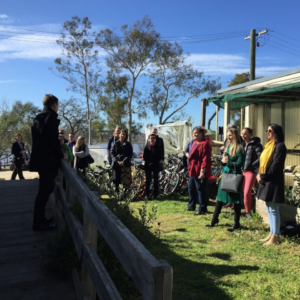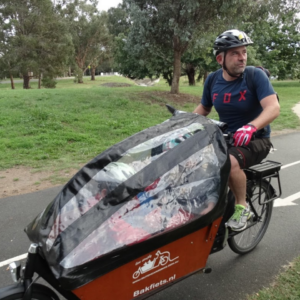
Plan your trips
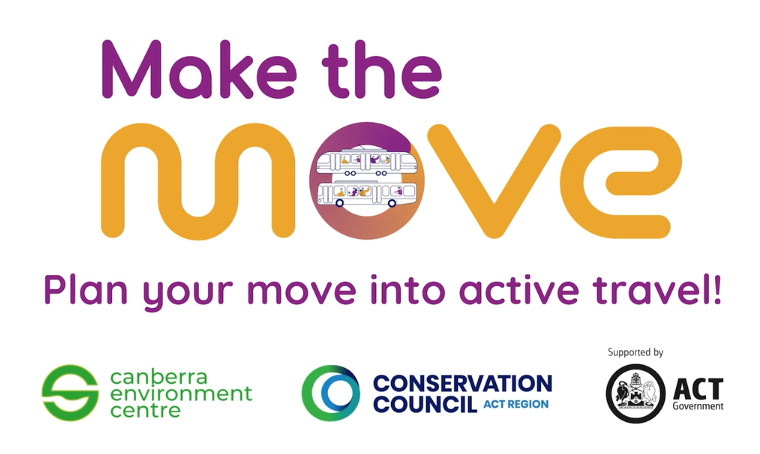
Understand your needs
Who is travelling, where, when and why?
Print a copy of the Action Planner [to be added shortly] or get some paper and pens and draw up a table of family members down the left column by days of the week across the top row then plot all the activities, times and locations. See the table for an example.
Set aside your current habits and look with fresh eyes at what trips can be eliminated or combined. Many start and finish times will be fixed, like school, but perhaps some of them could be negotiated to be more flexible to accommodate bus schedules or cycling. Remember that working from home also reduces car trips and frees up time for exercise and leisure activities. Consider breaking up complex trips, reallocating tasks and errands or doing some of them at different times to make active travel more feasible.
Journey planning
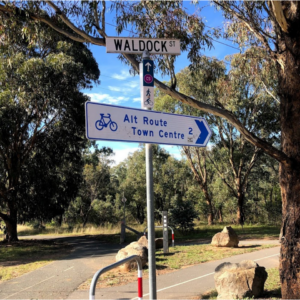
Just explore
Get to know your neighbourhood.
Canberra has an extensive network of shared paths, footpaths and quiet streets that connect local and major destinations and are perfect for walking and cycling. Explore your local community on foot or by bike, with or without a map. Learn where the paths go, particularly the ones that provide shortcuts in residential communities.
Maps and apps
Now it’s time to pull out maps and timetables and plan the ‘how’.
Transport Canberra’s (TC) Journey Planner, Walking and cycling maps, bus and light rail timetables, and Google Maps are essential tools. Both Journey Planner and Google Maps allow you to input start and finish locations, select the mode of travel, time bounds (“leave after” or “arrive before”) and some other options.
When getting public transport directions, Google Maps has a nifty “schedule explorer” feature below the list of route suggestions. Click the words “schedule explorer” to open a pop-up window that displays visual timelines for all of the options, making it super easy to find the quickest route combination and to plan around specific departure or arrival times.When planning cycle trips, consider routes other than the way you would drive. You’ll see new and more pleasant parts of the city: off-road paths are safer and side-streets have lower speed limits for cars.
Note that Transport Canberra’s Journey Planner for cycling shows the fastest route, which sometimes includes the bike lanes on major roads (like Adelaide Ave, Belconnen Way, Northbourne Ave, Hindmarsh Drive etc). If you want to avoid these, consult Transport Canberra’s walking and cycling maps. Google Maps displays alternatives and also shows the hill profiles for cycling or walking directions. Talk to other cyclists – they may have suggestions about more pleasant paths. Try some variations until you find a route that suits you – the shortest route may not be the most enjoyable.
Journeys to school
Give children the best opportunity to build walking and cycling habits as early as possible.
If they go to local schools, walking or cycling should be super simple. There are often footpaths that shortcut between streets and feed to central paths running past schools and local shops. Get in touch with the school to see if there are ‘walking school buses’ or talk to your child’s friends’ parents about the kids meeting up and walking together. Find more resources for parents and schools to help children ride or walk to school.
If schools are further away, check for dedicated school bus services. If there’s not one running through your suburb, plan a route on regular and rapid buses – catching regular routes to and from school builds greater independence to catch buses at other times. In the afternoons, look for cycle routes or bus services that your older child can take directly to their sport/ music/ orthodontist/ part-time job. Teenagers are often a lot more capable of cycling than their less fit parents!
Journeys to work
When you commute to and from the same place most days, it’s easy to develop new habits.
Working from home is a simple way to eliminate car trips. But when we do need to travel to work, the easiest way for couples to start active travel is for the person who has the simplest daily commute to swap out of their car and onto public transport or a bike, leaving the person with the more complex trips (eg multiple child activities) to use the family car.
If you travel from home to your workplace in the nearest town centre (eg Richardson to Tuggeranong, or MacGregor to Belconnen), a scooter or bike may be quite feasible. If you travel to a further town centre (eg Lyneham to Woden, or Oxley to Civic), an e-bike might bridge the distance.
Or go multi-modal with a ‘bike & ride’ combination of pushbike and public transport, eg cycle to the nearest interchange, lock your bike there or take it with you and catch a rapid bus or light rail. Cycling to and from a rapid bus can help overcome long waits between suburban bus connections and be more flexible for stopping by the local shops or school.
Perhaps one person could drop the other off to a bus or drive together to a ‘park & ride’ or ‘park & pedal’ facility and both get on buses or bikes. Enjoy the good bits on foot or a bike, skip the bad bits by hopping on a bus or light rail. Be aware that not all buses have racks and bike space is limited so you might need to wait for the next bus.
For meetings nearby during the day, try a share bike or scooter or ask your workplace to invest in some for staff use. Take a taxi or uber to get to appointments further afield or at night. Another option for travel to and from work is to find some colleagues who live nearby and form a car pool.
Remember that you don’t have to change every trip all at once. Set a modest goal, perhaps by swapping out car trips on just the easiest days of the week and then gradually swap out more as you get the hang of it. Every trip swapped is a “win”!
Have a back up plan
Say you get a flat tyre, or a storm rolls in, or your meeting runs late, or your child is sick and has to be picked up… You need a Plan B!
Keep a note of alternative times to leave work to catch an earlier or later bus. Bookmark your bus routes or print a copy to keep in your wallet. Get to know the bus routes that run past your suburb as well as through it. Make use of Google Maps’ schedule explorer feature to pick the quickest route.
Can you leave your bike securely at work or will it fit into your family car? Give yourself permission to call a taxi or Uber.
Learn how to fix a flat tyre and carry a repair kit.
See also What’s stopping you?
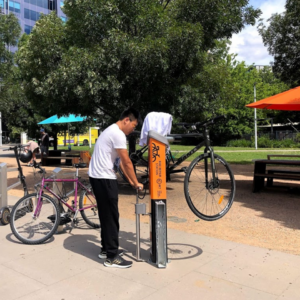
Make your next move ...
Download the free guide and action planner and make your first move into clean transport
